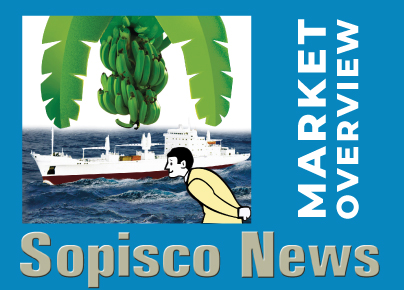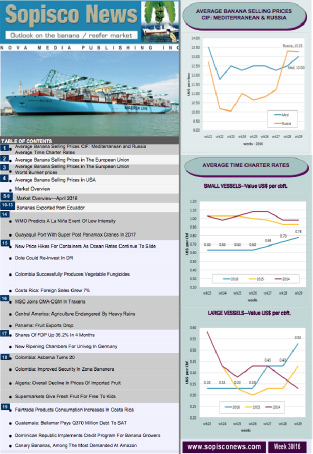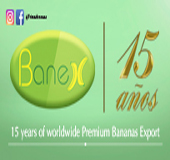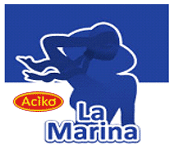Market Overview – Week 51/24
2024-12-20

In week 51, banana selling prices in St. Petersburg ranged from USD 17.45 to 18.40 per box CIF, depending on brand, volume, quality, and packing. Demand was weak. Nearly 2.09 million boxes were discharged, and around 1.41 million are expected for week 52.
The exchange rate was 1 USD = 103.42 RUB. Inflation in the Russian Federation since the beginning of the year amounted to 9.14%, and consumer prices for the week from December 10 to December 16 increased by 0.35%, from the beginning of December by 0.97%, and from the start of the year by 9.14%, as reported by Rosstat.
The Central Bank of Russia has kept its key interest rate at 21% despite market expectations of an increase. This decision comes amid high inflation and economic challenges, including the impact of Western sanctions and increased military spending. These economic factors are interconnected, with high inflation and a weak ruble contributing to the central bank's decision to keep interest rates high. The situation stays dynamic, with ongoing efforts to manage inflation and stabilize the currency.
In the Mediterranean, prices for Ecuadorian bananas ranged from USD 14.00 to 15.00 per box CIF, depending on brand, volume, packing, and region. In Libya, traders reported prices of USD 14.00 per box CIF for Ecuadorian bananas and around USD 13.00 per box CIF for bananas from Egypt.
In the Mersin Free Zone, prices were mainly at USD 14.50 to 15.50 per box for re-exported bananas of Ecuadorian origin, depending on brand, weight, volume, and packing, and around USD 2.00 less for other origins in Central or South America.
The exchange rate was 1 USD = 35.09 TL. The Turkish currency continued to lose ground against the USD.
The annual inflation rate in Turkey fell to 47.09% in November 2024, down from 48.58% in October. This marks the sixth consecutive period of gradual disinflation and the lowest rate since June 2023. The decrease is primarily driven by lower housing, water, electricity, gas, and fuel inflation. However, inflation for food and non-alcoholic beverages accelerated to a four-month high of 48.57%.
The Turkish lira has been experiencing significant devaluation. As of December 20, 2024, it had weakened by approximately 20% against the dollar since the start of the year. This decline is attributed to economic policies and interventions by state banks to sell dollars at weaker lira levels.
The Central Bank of Turkey has kept its key interest rate steady at 50% for the eighth consecutive meeting in November. Despite the high inflation, the central bank's decision to keep the interest rate is part of its efforts to stabilize the currency and manage inflation.
Last week, the Iranian market experienced instability due to energy, electricity, cold weather, and air pollution issues. As a result, all organizations, including banks, were closed for five days. These disruptions also affected banana prices. Ecuadorian bananas dropped to 75,000-80,000 IRT, while Indian bananas sold for 55,000-65,000 IRT. Indian banana prices for the 13.50 kg box have decreased to approximately USD 8.00 per-box CIF Bandar Abbas. Due to chilling injury, affected bananas are sold for around USD 7.00 per box.
Unexpectedly, the market weakened at the beginning of the week but recovered by the end of the Yalda Night, but despite this, traders still incurred losses. Yalda Night, also known as Shab-e Yalda or Shab-e Cheleh, is an ancient Persian festival celebrated on the longest night of the year, usually on December 20th or 21st. This year, it was celebrated on December 20, 2024.
Yalda Night marks the winter solstice and is a time for families and friends to gather and celebrate the arrival of longer days. Traditional foods such as pomegranates, watermelons, nuts, dried fruits, and bananas are enjoyed during this celebration. Yalda Night is also celebrated in Azerbaijan and Tajikistan.
Prices in the Ecuadorian spot market remain under pressure, and operations were affected by a shortage of containers. However, exporters of more valuable commodities such as shrimps have been proactive in their efforts to secure containers, even offering higher payments than standard freight rates. Despite these efforts being unsuccessful, it proves the industry's commitment to overcoming challenges. Additionally, some farms are grappling with issues such as Black Sigatoka and poor fertilization practices, largely due to a lack of resources.
About the Chartering Market, the entire fleet of large vessels has been engaged in the citrus and other fruit trade from South Africa and Morocco, as well as the grape and other fruit trade from Chile. Reports show that fruit volumes from Chile and Peru are more significant than last year, leading to increased use of specialised reefer vessels for the grape trade from Chile to the USA compared to the earlier season.
Industry sources expect the entire fleet of specialized reefer vessels to be employed across all trade segments, particularly after January-February. Owners and operators have been chartering vessels from other owners to expand their fleets.
Current time charter rates are approximately 70-80 US cents per cubic foot per month for larger vessels, depending on the nature of the voyage, and 80-85 US cents per cubic foot per month for smaller ships. Brokers expect rates to rise to 90-95 US cents per cubic foot per month starting in February.
Bunker Prices:
VLSFO MGO
Rotterdam $513.50 $652.00
Gibraltar $551.50 $725.00
Panama Canal $555.00 $695.00









